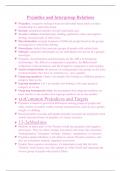Prejudice and Intergroup Relations
Prejudice: a negative feeling toward an individual based solely on their
membership in a particular group.
Racism: prejudiced attitudes toward a particular race.
Aversive racism: simultaneously holding egalitarian values and negative
feelings toward people of other races.
Discrimination: unequal treatment of different people based on the groups
or categories to which they belong.
Stereotypes: beliefs that associate groups of people with certain traits.
Subtype: categories that people use for individuals who do not fit a general
stereotype.
Prejudice, discrimination and stereotypes are the ABCs of intergroup
relationships. The Affective component is prejudice, the Behavioural
component is discrimination, and the Cognitive component is stereotyping.
Social categorisation: the process of sorting people into groups on the basis
of characteristics they have in common (e.g., race, gender).
Outgroup members (‘them’) are people who belong to a different group or
category than we do.
Ingroup members (‘us’) are people who belong to the same group or
category as we do.
Outgroup homogeneity bias: the assumption that outgroup members are
more similar to one another than ingroup members are to one another.
13-2 Common Prejudices and Targets
Prejudice is based on perceived differences among groups of people and
often centers on readily visible external characteristics, such as race, gender,
weight, or clothing.
Racial prejudice (racism) and gender prejudice (sexism) are among the most
widely discussed forms of prejudice in various societies.
13-2aMuslims
Muslims in many parts of the Western world face prejudice and negative
stereotypes. They are often wrongly associated with terms like 'extremist,'
'fundamentalist,' 'insurgent,' 'militant,' 'jihadist,' 'mujahideen,' or 'terrorist.'
Prejudice against Muslims is prevalent in various Western countries, and
they are sometimes unjustly regarded as terrorists.
Despite these negative stereotypes, it's important to note that the term
"Muslim" itself means 'one who submits to Allah (God)' and represents the
diverse group of people who practice Islam.
, Discrimination in employment exists for religious minorities, including
Muslims, as measured by access to job interviews, entry wages, and wait
times for call backs. Muslims can face challenges due to a lack of acceptance
of their religious identity.
Discrimination based on religion is not exclusive to Muslims; people of
other religions also experience discrimination. Pagans and atheists face the
highest levels of discriminatory treatment from employers, while Jews
receive no discernible discrimination.
Interestingly, a person's religion, while sometimes the reason for
discrimination, can also be a source of comfort and psychological well-
being. Engaging in Islamic practices can buffer the negative impact of
discrimination for Muslims.
13-2bXenophobia
Xenophobia is defined as a hatred or fear of foreigners. It involves
discriminatory practices and violence against foreign nationals.
In 1998, violence against foreign nationals, especially those from other
African countries, was identified as a significant social challenge in South
Africa. African foreigners were often perceived as an overwhelming,
uncontrollable mass entering the country illegally.
Words like 'flood,' 'descend,' and 'pour' were used to create the impression of
an unmanageable process, associating African foreigners with chaos,
disorder, and criminality.
Recent trends of violence against foreigners include indiscriminate mob
violence, individual attacks, intimidation, and looting campaigns specifically
targeting foreign-owned businesses.
Violent xenophobic attacks occurred in 2008 and 2015, with sporadic
incidents between and after these attacks.
In some cases, xenophobic attacks have emerged from service delivery
protests, where local residents protest the lack of services but some
protesters use the opportunity to attack and loot foreign-owned shops,
leaving South African-owned businesses untouched.
13-2cAlbinism
Albinism is a genetically inherited condition that affects about one in 20,000
people worldwide. It's more common in sub-Saharan Africa.
People with albinism face various physical, mental, emotional, and social
challenges.
In Africa, the experience of people with albinism is different from Western
countries, primarily because they do not stand out as much in regions where
the majority of the population has dark skin.




